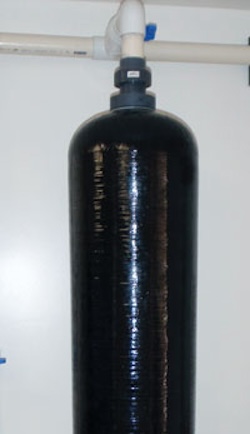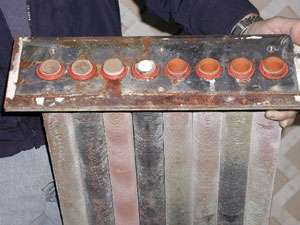Template-Assisted Crystallization
For some projects, an evaluation of uses in the building may require a number of techniques that will condition, filter and soften water as necessary. Although Reyneke recommends starting treatment with TAC water conditioning, he has paired this technology with additional water filters for total water technology management. After TAC, water may be engineered to flow to separate water “zones,” plumbing utility grade water to some areas of the building to use for fire suppression or toilet flushing, while treating others with carbon filters for drinking water.
Keith Karl, president of Water Resources Group, also recommends a hybrid approach to water system design and for water treatment at the National Gallery of Art in Washington, D.C., discussed in a later case study, combining TAC with environmental friendly sand filters and ultra-violet light. TAC combined with a complete water conservation plan can be important for designers who want to save water, energy and improve water quality.

Photo courtesy of Greg Reyneke, CWS-VI
This TAC unit installed at Sleeping Rainbow Ranch Environmental Research Station does not require electricity and uses very little space.
Capitol Reef National Park is located in the Waterpocket fold of South-central Utah. (Waterpockets are basins that form in exposed sandstone layers scoured by water.) This National Park is rich in red rocks with striated layers and a monocline, a steep, raised cliff that exposes the rich geologic history of the area for over a hundred miles. The Sleeping Rainbow Ranch Research Station is located in the heart of this area and counts among its resources numerous native plants, mammals, birds, reptiles, amphibians and fish. The water that scoured the rocks is now buried underground and drawn from a well for the renovation of the Sleeping Rainbow Ranch Environmental Research Station.
In 2009, architect Mark W. Chalom, LEED AP, designed new buildings for the station to maximize sustainability and preserve the scarce water resources and maximize solar energy. For Chalom, this meant that his staff researched and tested many alternatives from solar thermal hot water to low-flow showerheads. The program requirements for the building included the design of a water system for five buildings with 15 solar showers per building and a large fire suppression system.
When evaluating water supply for Sleeping Rainbow Ranch Environmental Research Station Greg Reyneke, CWS-VI, general manager at Intermountain Softwater, consulted with the architect, the National Park System and Utah Valley University to evaluate the existing water supply to find a solution to the problems that the mineral rich well water posed for the use of all of the water systems.
Due to the isolation of this facility, the owners required on an off-the grid solution designed for water conservation and energy efficiency. A comprehensive water analysis was made from the source water and samples found that even though the site was "pristine" the well water quality was not. Contaminants in the water included high levels of:
- Calcium carbonate which although not harmful for human consumption was of the level of hard water that would be prone to scaling and damaging to equipment
- Iron and manganese which causes serious staining issues
- Sulfate which has a laxative effect upon consumption as well as causing premature failure of water-using appliances
- Manganese which can cause additional staining
- Total dissolved solids (TDS) at such a high level of conductivity that can cause unpleasant taste, accelerating wear and tear on water-using appliances like water heaters and humidifiers
The owners and operators of the facility stipulated that no chemicals could be discharged through drainage systems on the site. The well was driven by intermittent solar power with no battery backup. There was irregular water pressure and flow rates among other complex and difficult issues that had to be faced by the designers who ultimately separated fire suppression systems from the well water and used a nitrogen system as an alternative.
The design water criteria for the project was not simple: provide the quantity of water required with the quality of water compliant with U.S. EPA and state of Utah primary drinking water standards. In addition, the system needed to minimize maintenance and capital costs. The solution included a layered approach to piping, water zoning and water distribution which began with a template-assisted crystallization (TAC) water conditioning unit. By flushing water through the TAC unit before storing the water in the tank, the engineers were able to treat the water so it would not create scale, which could clog piping, solar heaters and other equipment and fixtures throughout the campus.
By treating the water through a hybrid approach, the effect of TAC water conditioning along with a carefully planned nanofiltration system provided a reduction of the harmful elements from the natural water source and water treatment to the level of safe drinking water standards.

Photo courtesy of Watts
Example of tube bundles from a water heater where scale accumulation caused a single tube to block and burn out the bundle prematurely.
Hard water is not a health problem. In fact, the National Research Council (National Academy of Sciences) states that hard drinking water generally contributes a small amount toward total calcium and magnesium human dietary needs. They further state that in some instances, where dissolved calcium and magnesium are very high, water could be a major contributor of calcium and magnesium to the diet. Hard water is desirable for its mineral richness that benefits human health as well as a problem that can cause scaling on plumbing pipes and equipment in buildings. Hard water also interferes with a variety of cleaning processes, can stain equipment and may even have a stronger taste and smell than soft water.
As with most sustainability issues, water and building problems depend on where the building is located and the quality of the source water, the cold water that comes from either a well or a municipality to a building is a chemical mix of minerals, among these: calcium ions (Ca2+), magnesium ions (Mg+2) and bicarbonate ions (HCO3-). Hardness is a component of the total dissolved solids measured by the amount of calcium and magnesium in the water. The Water Research Council classifies measures of water hardness based on quantities calcium and magnesium. (See Sidebar.)
Scale is a mineral compound consisting mainly of calcium or magnesium carbonates in hard water. Scale can damage plumbing, appliances and other equipment. Accumulation of scale in water heating equipment causes a steady drop in efficiency and ultimately costly maintenance or worse, the need for replacement. Hard water effects in the home or apartments include:
- Spotted dishes from the dishwasher
- Soap scum deposits from an inability for soap to lather
- Scale formation on faucets and showerheads
- Scale accumulation in plumbing pipes
- Scale formation on appliances
- Losses of efficiency
- Higher costs of maintenance
- Shorter life of equipment
- More time cleaning









